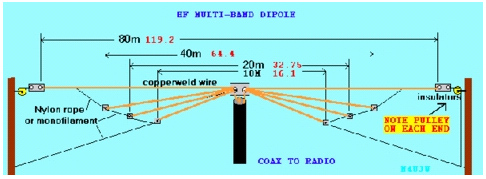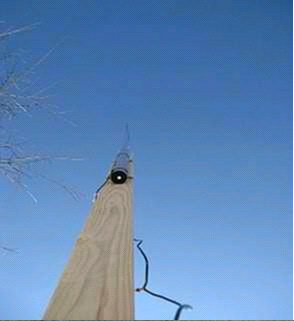Coax balun on PVC form
My experience is that PVC works fine as a form for high Q RF coils. I’ve measured Qs of up to 450 on loading coils wound on PVC pipe. I’ve appended a paper I wrote on measurements of coaxial baluns wound on PVC forms.
Having access to a Hewlett-Packard 4193A vector impedance meter at work, I have made measurements on a number of baluns, coaxial and otherwise. For my beams I was particularly interested how many turns and on what diameter are optimum for air core coaxial baluns, and what the effect of bunching the turns was (formless). Using the remote programming capability of the HP4193A along with an instrument controller, I measured the magnitude and phase of each balun’s winding impedance at 1 MHz intervals from 1 to 35 MHz. For comparison, I also made measurements on a commercial balun which consists of a number of ferrite beads slipped over a short length of coax. I’ve appended some of these measurements so you can draw your own conclusions.
PVC pipe was used for coil forms. The 4-1/4 inch diameter baluns were wound on thin-walled PVC labeled “4 inch sewer pipe”. This material makes an excellent balun form. It’s very light weight and easy to work with, and I obtained a 10 foot length at the local Home Depot for about 3 dollars. The 6-5/8 inch diameter forms are 6 inch schedule 40 PVC pipe which is much thicker, heavier, and more expensive.
Each test choke was close-wound on a form as a single-layer solenoid using RG-213 and taped to hold the turns in place. The lengths of cable were cut so there was about 2 inches excess at each end. This allowed just enough wire at the ends for connections to the HP4193A’s probe tip. After data was collected for each single-layer configuration, the PVC form was removed, the turns were bunched together and taped formless, and another set of measurements was taken. I have only included the “bunched” measurements in the table for one of the baluns, but the trend was the same in each case. When compared to the single-layer version of the same diameter and number of turns, the bunched baluns show a large downward shift in parallel self-resonance frequency and poor choking reactance at the higher frequencies.
Interpreting the Measurements
All the baluns start out looking inductive at low frequencies, as indicated by the positive phase angles. As the frequency is increased, a point is reached where the capacitance between the windings forms a parallel resonance with the coil’s inductance. Above this frequency, the winding reactance is reduced by this capacitance. The inter winding capacitance increases with the number of turns and the diameter of the turns, so “more is not always better”.
The effects of a large increase in inter winding capacitance is evident in the measurements on the balun with the bunched turns. This is probably a result of the first and last turns of the coil being much closer together than the single-layer coil. An important requirement of these baluns is that the magnitude of the winding reactance be much greater than the load impedance. In the case of a 50 ohm balanced antenna, the balun’s winding impedance is effectively shunted across one half the 50 ohm load impedance, or 25 ohms. A reasonable criteria for the balun’s winding impedance for negligible common mode current in the shield is that it be at least 20 times this, or 500 ohms. The measurements show, for example, that 6 turns 4-1/4 inches in diameter meet this criteria from 14 to 35 MHz.
The measurement data also reveals the power loss these baluns will exhibit. Each of the measurement points can be transformed from the polar format of the table to a parallel equivalent real and reactive shunt impedance. The power dissipated in the balun is then the square of the voltage across it divided by the real parallel equivalent shunt impedance. While this calculation can be made for each measurement point, an approximate number can be taken directly from the tables at the parallel resonance points. At 0 degrees phase angle the magnitude numbers are pure resistive. I didn’t record the exact resonance points, but it can be seen from the tables that the four single-layer baluns are all above 15K ohms, while the ferrite bead balun read about 1.4K. These baluns see half the load voltage, so at 1500 watts to a 50 ohm load, the power dissipated in the coaxial baluns will be less than 1.3 watts, and the ferrite bead balun will dissipate about 13.4 watts (neglecting possible core saturation and other non-linear effects). These losses are certainly negligible. At 200 ohms load impedance, the losses are under 5 watts for the coaxial baluns and 53.6 watts for the ferrite beads.
Conclusions
– A 1:1 coaxial balun with excellent choking reactance for 10 through 20 meters can be made by winding 6 turns of RG-213 on inexpensive 4 inch PVC sewer pipe.
– For 40 or 30 meters, use 12 turns of RG-213 on 4 inch PVC sewer pipe.
– Don’t bunch the turns together. Wind them as a single layer on a form. Bunching the turns kills the choking effect at higher frequencies.
– Don’t use too many turns. For example, the HyGain manuals for my 10 and 15 meter yagis both recommend 12 turns 6 inches in diameter. At the very least this is about 3 times as much coax as is needed, and these dimensions actually give less than the desired choking impedance on 10 and 15 meters.
Measurements
————
Magnitude in ohms, phase angle in degrees, as a function of frequency in Hz, for various baluns.
6 Turns 12 Turns 4 Turns 8 Turns 8 Turns Ferrite
4-1/4 in 4-1/4 in 6-5/8 in 6-5/8 in 6-5/8 in beads
sngl layer sngl layer sngl layer sngl layer bunched (Aztec)
———- ———- ———- ———- ———- ———-
Frequency Mag Phase Mag Phase Mag Phase Mag Phase Mag Phase Mag Phase
1.00E+06 26 88.1 65 89.2 26 88.3 74 89.2 94 89.3 416 78.1
2.00E+06 51 88.7 131 89.3 52 88.8 150 89.3 202 89.2 795 56.1
3.00E+06 77 88.9 200 89.4 79 89.1 232 89.3 355 88.9 1046 39.8
4.00E+06 103 89.1 273 89.5 106 89.3 324 89.4 620 88.3 1217 26.6
5.00E+06 131 89.1 356 89.4 136 89.2 436 89.3 1300 86.2 1334 14.7
6.00E+06 160 89.3 451 89.5 167 89.3 576 89.1 8530 59.9 1387 3.6
7.00E+06 190 89.4 561 89.5 201 89.4 759 89.1 2120 -81.9 1404 -5.9
8.00E+06 222 89.4 696 89.6 239 89.4 1033 88.8 1019 -85.7 1369 -15.4
9.00E+06 258 89.4 869 89.5 283 89.4 1514 87.3 681 -86.5 1295 -23.7
1.00E+07 298 89.3 1103 89.3 333 89.2 2300 83.1 518 -86.9 1210 -29.8
1.10E+07 340 89.3 1440 89.1 393 89.2 4700 73.1 418 -87.1 1123 -35.2
1.20E+07 390 89.3 1983 88.7 467 88.9 15840 -5.2 350 -87.2 1043 -39.9
1.30E+07 447 89.2 3010 87.7 556 88.3 4470 -62.6 300 -86.9 954 -42.7
1.40E+07 514 89.3 5850 85.6 675 88.3 2830 -71.6 262 -86.9 901 -45.2
1.50E+07 594 88.9 42000 44.0 834 87.5 1910 -79.9 231 -87.0 847 -48.1
1.60E+07 694 88.8 7210 -81.5 1098 86.9 1375 -84.1 203 -87.2 778 -51.8
1.70E+07 830 88.1 3250 -82.0 1651 81.8 991 -82.4 180 -86.9 684 -54.4
1.80E+07 955 86.0 2720 -76.1 1796 70.3 986 -67.2 164 -84.9 623 -45.9
1.90E+07 1203 85.4 1860 -80.1 3260 44.6 742 -71.0 145 -85.1 568 -51.2
2.00E+07 1419 85.2 1738 -83.8 3710 59.0 1123 -67.7 138 -84.5 654 -34.0
2.10E+07 1955 85.7 1368 -87.2 12940 -31.3 859 -84.3 122 -86.1 696 -49.9
2.20E+07 3010 83.9 1133 -87.8 3620 -77.5 708 -86.1 107 -85.9 631 -54.8
2.30E+07 6380 76.8 955 -88.0 2050 -83.0 613 -86.9 94 -85.5 584 -57.4
2.40E+07 15980 -29.6 807 -86.3 1440 -84.6 535 -86.3 82 -85.0 536 -58.8
2.50E+07 5230 -56.7 754 -82.2 1099 -84.1 466 -84.1 70 -84.3 485 -59.2
2.60E+07 3210 -78.9 682 -86.4 967 -83.4 467 -81.6 60 -82.7 481 -56.2
2.70E+07 2000 -84.4 578 -87.3 809 -86.5 419 -85.5 49 -81.7 463 -60.5
2.80E+07 1426 -85.6 483 -86.5 685 -87.1 364 -86.2 38 -79.6 425 -62.5
2.90E+07 1074 -85.1 383 -84.1 590 -87.3 308 -85.6 28 -75.2 387 -63.8
3.00E+07 840 -83.2 287 -75.0 508 -87.0 244 -82.1 18 -66.3 346 -64.4
3.10E+07 661 -81.7 188 -52.3 442 -85.7 174 -69.9 9 -34.3 305 -64.3
3.20E+07 484 -78.2 258 20.4 385 -83.6 155 -18.0 11 37.2 263 -63.2
3.30E+07 335 -41.4 1162 -13.5 326 -78.2 569 -0.3 21 63.6 212 -58.0
3.40E+07 607 -32.2 839 -45.9 316 -63.4 716 -57.6 32 71.4 183 -40.5
3.50E+07 705 -58.2 564 -56.3 379 -69.5 513 -72.5 46 76.0 235 -29.6
Ed Gilbert, WA2SRQ
















